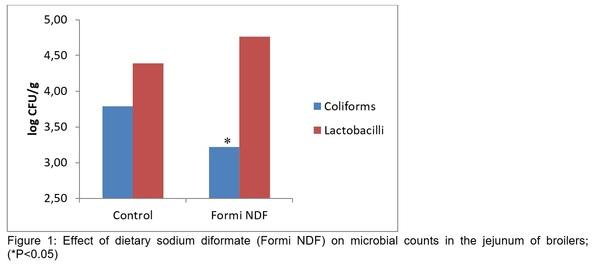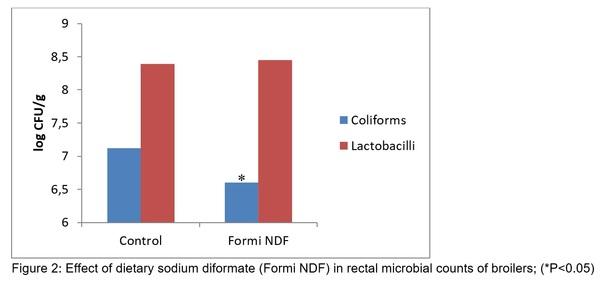The impact of dietary diformates (Formi NDF) on gut health in poultry as an alternative to AGP
Published: December 5, 2017
By: Christian Lückstädt, ADDCON GmbH, Bitterfeld, Germany; Nicolas Greiffenstein; ADDCON GmbH, Bogota, Colombia.
Enteric disorders are one of the most important groups of diseases which affect poultry production world-wide and they are continuing to cause high economic losses due to increased mortality rates, decreased weight gain, increased medication costs, and increased feed conversion rates (HAFEZ, 2011). Estimates of the annual costs of poultry-associated cases of salmonellosis and campylobacteriosis, two major causes of foodborne diseases in humans, in the United States alone ranged from $64 million to $114.5 million and $362 million to $699 million, respectively (BRYAN AND DOYLE, 1995). In the past this hazard was controlled by the prophylactic use of antibiotics. Since the EU ban on antibiotic growth promoters (AGP) in 2006, which led other markets to consider similar steps, new strategies against gastrointestinal diseases in livestock have been developed. Organic acids and their salts are commonly used to suppress gastrointestinal disorders and thereby improve productivity. Potassium diformate for instance, is the first substance with EU-approval as a non-antibiotic growth promoter for pigs.
Improving broiler performance or hygienic conditions with the aid of organic acids has been reported by many sources, as reviewed by DESAI ET AL. (2007). An important limitation, however, is that organic acids are rapidly metabolized in the fore-gut (crop to gizzard) of birds, which will reduce their impact on growth performance. A new molecule (sodium diformate, traded as Formi® NDF) has been proven to be effective against pathogenic bacteria, including Salmonella, along the whole gastro-intestinal tract (LÜCKSTÄDT AND THEOBALD, 2009). The reduced impact of pathogenic bacteria on the broiler, as well as the improved gut microflora, leading to a state of eubiosis in treated chickens, suggests that including diformate in broiler diets will also result in improved bird performance. Several trials have also been carried out over the last half-decade world-wide that document positive effects on broiler performance.
A study by LÜCKSTÄDT (2013) analyzed the average impact of dietary NDF from all studies on the effect on weight gain, feed efficiency, mortality and productivity, against a negative control. The final data-set contained the results of 8 documented studies, comprising 17 trials with NDF-inclusion, which ranged from 0.1% to 0.6%. Those studies were carried out between 2006 and 2012 in China, France, Russia, Taiwan, Thailand and Vietnam under both commercial and institutional conditions and included more than 36,700 broilers from different breeds (Arbor Acres, Cobb, Hubbard) raised to between 35 and 44 days. The average level of dietary NDF from the data-set in all treated broilers was 0.28%. The typical dosage for NDF in broilers under commercial conditions ranged from 1-3 kg/t feed, depending on age (dietary protein level) and hygienic status of the farm. As shown in Table 1, NDF inclusion resulted in a numerical increase in feed intake of 1.1% (P=0.22).
Improving broiler performance or hygienic conditions with the aid of organic acids has been reported by many sources, as reviewed by DESAI ET AL. (2007). An important limitation, however, is that organic acids are rapidly metabolized in the fore-gut (crop to gizzard) of birds, which will reduce their impact on growth performance. A new molecule (sodium diformate, traded as Formi® NDF) has been proven to be effective against pathogenic bacteria, including Salmonella, along the whole gastro-intestinal tract (LÜCKSTÄDT AND THEOBALD, 2009). The reduced impact of pathogenic bacteria on the broiler, as well as the improved gut microflora, leading to a state of eubiosis in treated chickens, suggests that including diformate in broiler diets will also result in improved bird performance. Several trials have also been carried out over the last half-decade world-wide that document positive effects on broiler performance.
A study by LÜCKSTÄDT (2013) analyzed the average impact of dietary NDF from all studies on the effect on weight gain, feed efficiency, mortality and productivity, against a negative control. The final data-set contained the results of 8 documented studies, comprising 17 trials with NDF-inclusion, which ranged from 0.1% to 0.6%. Those studies were carried out between 2006 and 2012 in China, France, Russia, Taiwan, Thailand and Vietnam under both commercial and institutional conditions and included more than 36,700 broilers from different breeds (Arbor Acres, Cobb, Hubbard) raised to between 35 and 44 days. The average level of dietary NDF from the data-set in all treated broilers was 0.28%. The typical dosage for NDF in broilers under commercial conditions ranged from 1-3 kg/t feed, depending on age (dietary protein level) and hygienic status of the farm. As shown in Table 1, NDF inclusion resulted in a numerical increase in feed intake of 1.1% (P=0.22).

However, although feed intake was not improved significantly by NDF inclusion, the performance of broilers, based on daily gain, was significantly increased by 5.2% (P<0.001). Furthermore, the FCR was also significantly improved (4.1%; P<0.01). Survival was increased on average by 2.3% (P<0.05). Finally, the European Broiler Index (EBI) improved highly significantly by 12.4% (P<0.001), due to the inclusion of NDF. This finding is a result of improvements in all 3 of these parameters, indicating a potential for greater economic output.
The superior performance of broilers fed with sodium diformate can be explained in many ways. Analysis showed a clear effect of dietary NDF on nutrient utilization (LÜCKSTÄDT AND MELLOR, 2013) Crude protein utilization was improved from 61.6% to 63.5% in the acidifier group, a rise of 3%; while the effect on crude fat utilization was significant (90.5% vs. 91.6% in control and treatment groups, respectively). This improved nutrient utilization and better bird performance can be explained by the enlarged gut surface area due to the dietary acidifier. Increased gut surface area allows better absorption of nutrients across the mucosal layer. The length of micro-villi is especially important in determining the available surface area for nutrient uptake. Micro-villi in the jejunum were numerically increased in length from 1268µm to 1434 µm (13% longer), whereas the same parameter in the ileum was significantly increased (1011b vs. 1194a µm, more than 18%).
It is often reported that dietary acidifiers consisting of organic acids or their salts can counteract potential pathogenic bacteria in livestock production. LÜCKSTÄDT AND MELLOR (2013) analysed the effect of dietary NDF on jejunal and rectal microbial counts in broilers (Fig. 1, Fig. 2).
The superior performance of broilers fed with sodium diformate can be explained in many ways. Analysis showed a clear effect of dietary NDF on nutrient utilization (LÜCKSTÄDT AND MELLOR, 2013) Crude protein utilization was improved from 61.6% to 63.5% in the acidifier group, a rise of 3%; while the effect on crude fat utilization was significant (90.5% vs. 91.6% in control and treatment groups, respectively). This improved nutrient utilization and better bird performance can be explained by the enlarged gut surface area due to the dietary acidifier. Increased gut surface area allows better absorption of nutrients across the mucosal layer. The length of micro-villi is especially important in determining the available surface area for nutrient uptake. Micro-villi in the jejunum were numerically increased in length from 1268µm to 1434 µm (13% longer), whereas the same parameter in the ileum was significantly increased (1011b vs. 1194a µm, more than 18%).
It is often reported that dietary acidifiers consisting of organic acids or their salts can counteract potential pathogenic bacteria in livestock production. LÜCKSTÄDT AND MELLOR (2013) analysed the effect of dietary NDF on jejunal and rectal microbial counts in broilers (Fig. 1, Fig. 2).

The count of coliform-bacteria in the jejunum was significantly (P<0.05) reduced (3.79 vs. 3.22 log CFU/g DM) due to the dietary treatment, whereas the amount of lactobacilli in the jejunum was even numerically increased by 8% (4.39 vs. 4.76 log CFU/g DM).

Bacterial counts in the rectum showed a similar trend. The count of coliform-bacteria in the rectum, even if at a higher log-level, was significantly (P<0.05) reduced (7.12 vs. 6.60 log CFU/g DM) in birds fed with NDF, whereas the amount of lactobacilli remained roughly the same (8.39 vs. 8.45 log CFU/g DM).
The reduced bacterial pressure through potentially pathogenic coliforms may be reflected in an improved immune status, which can be seen through an increased bursa weight (0.11% vs. 0.15% of whole carcass weight in control and NDF treatment groups, respectively). The bursa is among the important organs for B-cell development, which are part of the immune system, in birds. It is especially active in young birds and it may be speculated that the numerical increase in bursa weight in the NDF-fed broiler shows an improved immune status of these birds.
Subsequently, NDF was tested against an antibiotic growth promoter (Colistin) in order to demonstrate similar effects in poultry where the use of AGP is still allowed, as in South America.
The trial was conducted under large scale conditions in Ceará, Brazil (LÜCKSTÄDT, GREIFFENSTEIN AND DARI, 2014) and aimed to test NDF against a commercial broiler diet containing an antibiotic growth promoter (Colistin). Feed and water were available ad libitum. Around 500,000 one day old birds from 33 different houses were included in the study and were compared to the same number of birds (from the same houses) and their subsequent performance from the previous year. Performance data were measured at the end of the trial and the European Broiler Index (EBI), thus combining the three most important parameters in broiler production.
The average growth period was 45 days. The positive control group used 60 g Colistin per t of feed for the first 21 days, while the treatment group added 0.1% NDF during the same time period. EBI data were analysed using the t-test. The results are given as mean ± SD with a confidence level of 95%.
EBI in the houses with 0.1% NDF was increased by 5.1% (P=0.006) – Table 2. Due to the inclusion of sodium diformate, in 10 out of 33 houses EBI reached a value above 300 (max. 331), whereas the Colistin-treated houses attained only a maximum EBI of 297 (see also Figure 3).
The reduced bacterial pressure through potentially pathogenic coliforms may be reflected in an improved immune status, which can be seen through an increased bursa weight (0.11% vs. 0.15% of whole carcass weight in control and NDF treatment groups, respectively). The bursa is among the important organs for B-cell development, which are part of the immune system, in birds. It is especially active in young birds and it may be speculated that the numerical increase in bursa weight in the NDF-fed broiler shows an improved immune status of these birds.
Subsequently, NDF was tested against an antibiotic growth promoter (Colistin) in order to demonstrate similar effects in poultry where the use of AGP is still allowed, as in South America.
The trial was conducted under large scale conditions in Ceará, Brazil (LÜCKSTÄDT, GREIFFENSTEIN AND DARI, 2014) and aimed to test NDF against a commercial broiler diet containing an antibiotic growth promoter (Colistin). Feed and water were available ad libitum. Around 500,000 one day old birds from 33 different houses were included in the study and were compared to the same number of birds (from the same houses) and their subsequent performance from the previous year. Performance data were measured at the end of the trial and the European Broiler Index (EBI), thus combining the three most important parameters in broiler production.
The average growth period was 45 days. The positive control group used 60 g Colistin per t of feed for the first 21 days, while the treatment group added 0.1% NDF during the same time period. EBI data were analysed using the t-test. The results are given as mean ± SD with a confidence level of 95%.
EBI in the houses with 0.1% NDF was increased by 5.1% (P=0.006) – Table 2. Due to the inclusion of sodium diformate, in 10 out of 33 houses EBI reached a value above 300 (max. 331), whereas the Colistin-treated houses attained only a maximum EBI of 297 (see also Figure 3).

In broilers, improved zootechnical performance is thought to stem from both improvements in the intestinal microflora, as a result of suppressing pathogenic bacterial species; and improved protein digestion. GANGULY (2013) reported in this regard “…Organic acids reduce the growth of many pathogenic and non-pathogenic intestinal bacteria, decrease intestinal colonisation and reduce infections, ultimately decreasing inflammatory processes at the intestinal mucosa.” Furthermore, VAN DER SLUIS (2000) estimated that poor intestinal integrity can result in economic losses of up to 10 cents per bird. As often seen with other additives, hygiene also plays some role in the performance achieved. The average impact of NDF against an antibiotic growth promoter on the performance index remained above that normally expected. It can therefore be speculated that the benefit to feed efficiency found when NDF was included in diets, may not only stem from better gut integrity, but also as a direct result of the additive’s impact on protein digestibility. This was suggested, for instance, by SELLE ET AL. (2004) who found that the use of diformates in broilers improved nitrogen retention.

These findings lead to the conclusion that the addition of 0.1% sodium diformate (Formi NDF) considerably improves overall broiler performance, combining effects on daily gain, survival and feed efficiency, even when compared to the use of an AGP.
ADDCON was invited to give this lecture at the “XXV Congreso Latinoamericano de Avicultura” in Guadalajara, Mexico – which was held from September 26-29, 2017. Article by Dr. Christian Lückstädt, ADDCON’s Technical Director for the Feed Business Unit. "El impacto de los diformados dietéticos en la salud intestinal en las aves de corral como una alternativa a los antibióticos promotores de crecimiento".
References
BRYAN, F.L. AND DOYLE, M.P. (1995). Health risks and consequences of Salmonella and Campylobacter jejuni in raw poultry. Journal of Food Protection 3: 229-344.
DESAI, D., PATWARDHAN, D. AND RANADE, A. (2007). Acidifiers in Poultry Diets and Poultry Production. In: LÜCKSTÄDT, C.: Acidifiers in Animal Nutrition – A Guide for Feed preservation and Acidification to Promote Animal Performance. 30 Nottingham University Press, Nottingham, 63-69.
GANGULY, S. (2013). Potential nonantibiotic growth promoting dietary supplements for animal nutrition: A Review. Journal of Applied Pharmaceutical Science 3(7):174-178. HAFEZ, H.M. (2011). Enteric diseases of poultry with special attention to Clostridium perfringens. Pakistan Veterinary Journal 31 (3): 175-184.
LÜCKSTÄDT, C. (2013). Effects of dietary sodium diformate in broilers – a performance analysis. Proceedings of the 19th European Symposium on Poultry Nutrition: 191. LÜCKSTÄDT, C., GREIFFENSTEIN, N. AND DARI, R. (2014). Effect of dietary sodium diformate in broilers on the productivity index against a positive control. Book of Abstracts Tropentag 2014: 168.
LÜCKSTÄDT, C. AND MELLOR, S. (2013). Sodium diformate in broiler diets: A new approach for sustainable poultry production. Feed Business Worldwide, March 2013: 52- 54.
LÜCKSTÄDT, C. AND THEOBALD, P. (2009). Effect of a formic acid-sodium formate premixture on Salmonella, Campylobacter and further gut microbiota in broilers. Proceedings and Abstracts of the 17th European Symposium on Poultry Nutrition: 246. SELLE, P.H., HUANG, K.H. AND MUIR, W.I. (2004). Effects of potassium diformate inclusion in broiler diets on growth performance and nutrient utilisation. Proceedings Australian Poultry Science Symposium: 55-58.
VAN DER SLUIS, W. (2000). Clostridial enteritis is an often underestimated problem. World Poultry 16: 42–43.
Related topics:
Authors:
ADDCON
ADDCON
Influencers who recommended :
Christoph Hutter, Kurt Wegleitner and 1 moreRecommend
Comment
Share
11 de diciembre de 2017
Being a good AGP substitute, it should take care both Gram negative and Gram Positive pathogens in the gut. So, could you please explain the mode of action of diformates (formi NDF) against Gram negative (like E.coli & Salmonella) and Gram Positive (like Clostridia)???
Recommend
Reply

Would you like to discuss another topic? Create a new post to engage with experts in the community.










.jpg&w=3840&q=75)